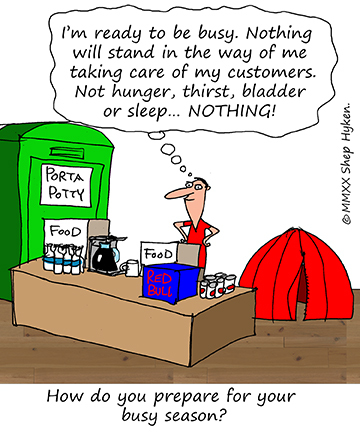Shep Hyken's Blog, page 113
January 7, 2020
Amazing Business Radio: David Meerman Scott

Customer Fandom
How to Build Your Customer Fanbase
Shep Hyken interviews David Meerman Scott. They discuss his new book, Fanocracy: Turning Fans into Customers and Customers into Fans, and strategies for businesses to turn their customers into fans and vice versa.








Top Takeaways:
Human beings naturally crave connection and the feeling of belonging. That’s where the concept of the “fandom” comes into play. Companies must figure out how they can utilize this to their advantage. Every organization is capable of developing fans.
Companies can turn fans into customers by tapping into an already existing fanbase. For example, an auto insurance company found a fanbase for old cars and began catering to that market.
Companies can also turn customers into fans. If you can find a way to connect to your customers on a deeper level, they will feel more connected to you and your business. This is where fandom begins.
The neurology behind fandoms explains how and why they are so successful. The closer you are to people physically, the stronger the shared emotion. This is the secret to creating deep, authentic connections.
Other factors can contribute to the creation of customer “fans” and a loyal fanbase, such as the exclusivity factor, subscription, and the ability to share on social platforms. These can all give customers a feeling of belonging and connection.
Avoid creating an adversarial relationship with your customers. Remove barriers for your customers to access your content. For example, provide the free ebook first and later ask for the customer’s email, instead of the other way around. This will generate more interest and hotter leads—and create fans.
Be passionate. Even if the person you’re interacting with doesn’t share your passion, they can feel it. Passion is infectious. Customers like doing business with people who are passionate.
Quotes:
“Fandom is all about a true human connection—a personal connection. It’s hard-wired into our brains as humans that we want to be part of a tribe, that we want to be together with like-minded people.” -David Meerman Scott
“Our work is our life and our life is our work. If you love what you do and bring the things you love into your work, you show passion. People who share passion have more fans. Companies who employ passionate people develop more fans. Passion grows businesses.” -David Meerman Scott
About:
David Meerman Scott is a marketing strategist, entrepreneur, advisor to emerging companies, VC strategic partner and bestselling author of 10 books, including Fanocracy: Turning Fans into Customers and Customers into Fans.
Shep Hyken is a customer service and experience expert, New York Times bestselling author, award-winning keynote speaker, and your host of Amazing Business Radio.
The post Amazing Business Radio: David Meerman Scott appeared first on Shep Hyken.
January 6, 2020
5 Top Customer Service Articles for the Week of January 6, 2020
Each week I read a number of customer service and customer experience articles from various resources. Here are my top five picks from last week. I have added my comment about each article and would like to hear what you think too.
8 CX Design & Strategy Trends You Need To Know: Looking Back On The 2019 Contact Center by Matt Wujciak
(CCW DIgital) This article shares 8 key findings on CX Design and Strategy, according to our 2019 market study.
My Comment: What’s your ROX (Return on experience)? The concept of ROX is a new one. This excellent article from the good people at CCW, who put on several amazing conferences for the customer support world cover eight strategies in the contact center. That said, ROX can apply to any part of the customer experience.
6 Ways to Upgrade Your Customer Experience in 2020 by Gene Hammett
(Inc.) If your goal for 2020 is rapid growth, your customer experience has to outpace your competition’s.
My Comment: This list has something for every company in any industry. I’m intrigued by the first of the six ideas, which focuses on culture, but not the corporate culture. It is about being in alignment with the customer and society’s culture.
Employee Experience and Customer Experience Depend on Strategy by Liliana Petrova
(The Petrova Experience) The three main solutions to frontline employee stressors are a well-designed customer experience strategy; a mapped out employee journey that drives the design and integration of every new tool; and a cross-functional, agile approach to building technology solutions that include frontline employees in the design phase.
My Comment: This article takes a look at the complicated process many customer-facing front-liners deal with. The best customer experience starts with a great employee experience. The author suggests three solutions to the employee experience that includes a well-designed CX strategy, a journey map focused on employees, not just customers, and considering the employee experience as you roll out new technology to make the customer’s experience better.
Knowledgeable and Friendly Agents Earn Customers for Life: Why Brand Trust Rides on the Customer Service Your Contact Center Agents Deliver by Veronica Krieg
(Sharpen) Learn how knowledgeable and friendly agents keep your revenue in check and build trust that keeps customers for life.
My Comment: More than just friendly customer service agents, you want knowledgeable agents. Consider this research from PWC, 46% of all consumers will abandon a company if the employees aren’t knowledgeable. And, while the focus is on the technical knowledge of a product or service the company offers, when you add in knowledge about the customer (their history, prior calls for support, buying patterns, etc.), you take the experience to an even higher level.
‘Hug It Out’ To Boost New Client Acquisition And Retention by Billy Polson
(Forbes) No matter what your product offering or service is, following the three steps below will help your new customers feel immediately more trusting of your business, while also helping to guarantee that there is never a shortage of hugs or good vibes between your business and your entire clientele.
My Comment: What if you could offer your customers, not a five-star experience, but an eleven-star experience? What would that look like? I love that question. It is similar to a question that I will sometimes use in my speeches and workshops: What would you do differently if your customers were willing to pay you ten times your asking price? Have a meeting and brainstorm what the eleven-star or 10X price looks like. You may be surprised at how you can improve, even if ever so slightly, the customer’s experience.
 Shep Hyken is a customer service expert, professional speaker and New York Times bestselling business author. For information on The Customer Focus
Shep Hyken is a customer service expert, professional speaker and New York Times bestselling business author. For information on The Customer Focus customer service training programs go to www.TheCustomerFocus.com. Follow on Twitter: @Hyken
customer service training programs go to www.TheCustomerFocus.com. Follow on Twitter: @Hyken
The post 5 Top Customer Service Articles for the Week of January 6, 2020 appeared first on Shep Hyken.
January 3, 2020
Guest Blog: How to Use Gamification to Improve Agent Motivation
This week we feature an article by Tom Paton who writes about how customer service teams are using gamification as a way to improve performance and retention.
Managing motivation can be a real struggle for customer service teams.
Even if you have the perfect systems in place, and the perfect processes for responding to each ticket, managing the human element in the support process can be a major challenge.
Unfortunately, some team leaders fail to get the most out of their customer support agents, leading to low morale and higher turnover.
Managing staff is far too big a topic for a single blog post. The Shep Hyken blog has some great resources on hiring the right staff and training them to become better problem solvers.
However, there’s a new method you can use to maximize motivation specifically.
More and more customer service teams are using gamification as a means of improving their team performance and staff retention.
What is gamification?
Gamification is essentially a means of integrating games into your support team’s processes. These could be standalone games or even something as simple as just using leaderboards.
How you implement gamification, and whether or not it is an appropriate strategy for your team, will depend on how your customer support process operates.
Many different teams have different ways of using this technique.
Benefits of gamification
There are a number of potential benefits to using gamification, depending on the game or games you decide to implement.
First and foremost, some games can help to create a sense of competition, inspiring individual agents (or teams) to provide even better customer service. Maximizing motivation is the main reason that most teams use gamification strategies.
Secondly, games can help to improve morale and minimize turnover. They can provide an extra sense of enjoyment, for example by emphasizing to an agent how helpful they have been through their progress on a leaderboard.
Finally, gamification can be used as a means of improving efficiency. If implemented correctly, games can help your team improve their focus not just on the quality of the support they are providing, but also the speed with which they respond.
Examples of gamification
Here are some ideas of games you could potentially implement in your customer support processes.
Note: as we discussed above, these are simply ideas. It’s a good idea to find a game to modify, or even formulate completely unique games, in order to use gamification effectively.
1. The Humble Leaderboard
Who has made the most resolutions this month? Or whose post-call survey results have been the most positive?
A leaderboard is the easiest way of promoting a little extra competition in your contact center. You could also rank teams instead of individual agents, if appropriate.
Be sure to include a prize at the end of the month or quarter, to inspire your team to achieve their best results.
2. Points
Depending on the solution you’re using to manage your support, it may be possible to get much more high-tech with the games you’re using.
If you want to get more in-depth, you can create more advanced leaderboards, with points assigned based on the types of resolutions made, rather than just the number.
Using cloud-based gamification solutions/plugins will also allow for the provisioning of virtual rewards, like pins and badges. However, the more technologically advanced you get, the more difficult the games will be to set up.
3. Hoarder
This is another example that is much easier to implement.
Grab two small, round fishbowls – one for each team. Split your office in half if there aren’t any teams already defined.
Next, find some tokens. Marbles or small bouncy balls work well.
To begin the game, split the tokens evenly between the two fishbowls. Each team can take a token from the other team’s bowl and put it in their own when they achieve a certain objective – 10 tickets resolved for example.
When a bowl empties, the other team wins the game.
Tom Paton loves to educate customers on improving information systems and broader business processes in the B2B space. He’s passionate about delivering better customer contact, in both inbound and outbound environments. Currently, Tom works for contactSPACE – a provider of cloud-based contact center software based in Sydney, Australia.
For more articles from Shep Hyken and his guest contributors go to customerserviceblog.com.

Read Shep’s latest Forbes article: Companies That Care: Charitable Contributions And Giving Back To The Community
The post Guest Blog: How to Use Gamification to Improve Agent Motivation appeared first on Shep Hyken.
January 1, 2020
New Year’s Reflections: Celebrate Your Accomplishments
 I’m going to break away from my typical articles about customer service and experience and get personal. It’s that time of year when we make New Year’s resolutions that, while well-intentioned, we quickly fall short of and often forget in a very short time. Personal goals about working out and losing weight seem to be the most popular. Those resolutions can often be frustrating, especially if they become a pattern of failure that repeats year after year.
I’m going to break away from my typical articles about customer service and experience and get personal. It’s that time of year when we make New Year’s resolutions that, while well-intentioned, we quickly fall short of and often forget in a very short time. Personal goals about working out and losing weight seem to be the most popular. Those resolutions can often be frustrating, especially if they become a pattern of failure that repeats year after year.
Instead of looking ahead into the New Year and getting frustrated, how about looking back over the past year at the accomplishments and things that happened in your life, both personally and professionally, that made you happy or proud? I have a little two-part exercise for you to do. The first part is to answer the following question:
“What ten things happened in the past year that you are most proud of or grateful for?”
Here are a few of mine:
In business, I did 47 speeches for amazing clients.
I had a great summer vacation with my wife.
I performed a magic show at an off-Broadway theatre in New York.
My son and I played guitar together.
I had an amazing time with my daughters on a recent trip to New York.
I watched the St. Louis Blues hockey team win the Stanley Cup—and was in the victory parade with the players.
You get the idea. These are some of my highlights of the year. Here’s what’s interesting; most of them are repeatable. Even the business accomplishment is likely to repeat itself, if not get better. The obvious exception is watching another Blues championship victory. That one is completely out of my control. I can only hope and cheer them on.
The other experiences I’m grateful for are completely within my control—making time for a vacation, practicing my sleight-of-hand for another magic show, taking time to be with my family, managing the business…. All of those happened because I made time for them and properly planned.
The second part of the exercise is to create a plan to repeat them.
In the investment world, there is a disclaimer that goes something like, “Past performance does not guarantee future performance.” While that may be true, the past gives you an example of what could happen. It’s the same with your accomplishments. You already achieved them—and you achieved them recently, within the past year.
Recognize what you are grateful for and proud of, and then find a way to repeat them. Don’t just think about it; commit it to paper. For business, you’ll make a plan. For your personal life, it may be as easy as taking out a calendar and blocking some dates. If you want to continue and expand on what you’re most proud of or grateful for in your life, first you must recognize what that is. Then, make a plan to repeat them. Make it purposeful.
Before I go, let me take this time to wish you the best year ever! May each year be even better than the last!
Shep Hyken is a customer service expert, keynote speaker, and New York Times bestselling business author. For information, contact 314-692-2200 or www.hyken.com. For information on The Customer Focus customer service training programs, go to www.thecustomerfocus.com. Follow on Twitter: @Hyken
customer service training programs, go to www.thecustomerfocus.com. Follow on Twitter: @Hyken
(Copyright © MMX, Shep Hyken)
The post New Year’s Reflections: Celebrate Your Accomplishments appeared first on Shep Hyken.
December 31, 2019
Amazing Business Radio: Lindsay Pedersen

The Emotional Brand Experience
How to Differentiate Your Brand Through Emotional Connection with Customers
Shep Hyken interviews Lindsay Pedersen. They discuss strategies for how brands can differentiate themselves by creating authentic, genuine connections with their customers.








Top Takeaways:
A brand is its customer experience and vice versa. The brand and the experience are built on the relationship between a business and its customers.
Advertising and marketing may attract new customers, but it’s rarely the real reason why customers like doing business with a brand. Customers like doing business with companies because of how those companies make them feel.
Many companies focus too much on acquiring new customers rather than retaining the customers they already have.
Every company should ask itself why it is in business. This question becomes especially important if the company keeps losing customers. Create an experience that reduces customer churn.
You must differentiate yourself from your competitors. Be wary of doing this through your product alone; that method is too easy to copy. But if find a way to meet a unique need for your customers, you will find success.
The most important question a company can ask itself is what emotional reward they want the customer to enjoy by choosing to do business with them. There is emotional value in the connection between a company and its customers, and brands must tap into that.
Quotes:
“Brand is the relationship between a business and its customer.” – Lindsay Pedersen
“The way a business makes us feel… that is the experience.” – Lindsay Pedersen
“Businesses don’t make money by impressing people with cool ads. They make money by attracting and retaining customers.” – Lindsay Pedersen
About:
Lindsay Pedersen is a brand strategist and owner of Ironclad Brand Strategy who recently authored Forging an Ironclad Brand: A Leader’s Guide. She has advised companies from burgeoning startups to national corporations.
Shep Hyken is a customer service and experience expert, New York Times bestselling author, award-winning keynote speaker, and your host of Amazing Business Radio.
The post Amazing Business Radio: Lindsay Pedersen appeared first on Shep Hyken.
December 30, 2019
5 Top Customer Service Articles for the Week of December 30, 2019
Each week I read a number of customer service and customer experience articles from various resources. Here are my top five picks from last week. I have added my comment about each article and would like to hear what you think too.
Using Social Media to Connect with Your Most Loyal Customers by Michael A. Stanko, Blanca Isabel Hernández Ortega, Francisco-Jose Molina-Castillo, Rishika Rishika, and José Franco
(Harvard Business Review) More and more companies have loyalty programs — and for good reason. A recent industry report showed that loyalty program members not only spend more and remain customers longer but they are also more likely to spread positive word of mouth.
My Comment: Want to get even closer to your most loyal customers? Create a better experience for them on social media. Several professors contributed to this short, but insightful, article about how to leverage social media in a way that drives higher revenue per customer. Note: Be careful not to move from relationship building to blatant marketing, or the strategy may backfire.
Customer experience trends to watch out for in 2020 by Mahir Prasad
(ClickZ) OpenText’s Nali Giliana highlights five key trends that will influence customer experience in 2020.
My Comment: Predictions and trends for the upcoming year are always interesting, and I’ve included several over the past few weeks in this roundup. This article included something worth considering. Voice search will become a key to a good customer experience – and the stat to back it up says as much as 80% of total customer interactions will be made by artificial intelligence. Be it Alexa, Google, Siri, etc., the response to customers’ questions are all managed by AI.
Delivering a more customer-centric experience by SmartBrief
(SmartBrief) This article shares five ways to get your employees excited and involved in creating a customer-centric experience.
My Comment: This short article emphasizes that the customer-centricity “doesn’t mean your employees take a backseat (to customers).” On the contrary, customer centricity starts inside of the organization. It is part of the culture. The article includes five ideas. All are good, but perhaps one of the most powerful – and simplest – is the first one, which is to host brainstorm sessions with different departments.
Good, the Bot and the Customer Experience: Five tips for brands looking to embrace AI-driven customer service by Arun Mani
(ITProPortal) Tips for brands looking to embrace AI-driven customer service.
My Comment: As you continue or think about rolling out more and more self-service solutions to help your customers get the answers they need quickly, you must also consider that the more “digital” you go, the further away you’re getting from maintaining real connections with your customers. This article includes several insights you need to avoid a customer service disconnect.
How Complaining Customers Can Become Your BBFs (Best Business Friends) by Alex Zlatin
(Franchising.com) Dealing with customer complaints isn’t a business owner’s favorite task. However, that sometimes stressful part of running a company can provide opportunities to improve the business in the long run.
My Comment: This short article reminds of that a complaint is actually a gift. When you manage your customer’s complaints or problems well you earn their loyalty. Also, their complaints may give you the insight to create a better process, which leads to more customers. Customers love to do business with the places they know will take care of them – even when there’s a problem.
BONUS
8 Experts on Changing Up Your Marketing Strategy in 2020 by Wild Coffee
(Wild Coffee Marketing) Want a bold new marketing plan for 2020? Learn from 8 well-known marketing professionals.
My Comment: Customer experience and marketing are often intertwined. Here are eight experts commenting on how to improve your marketing, and it’s an honor for my comments to be included in the article. Remember… a good CX can be some of your best marketing!
 Shep Hyken is a customer service expert, professional speaker and New York Times bestselling business author. For information on The Customer Focus
Shep Hyken is a customer service expert, professional speaker and New York Times bestselling business author. For information on The Customer Focus customer service training programs go to www.TheCustomerFocus.com. Follow on Twitter: @Hyken
customer service training programs go to www.TheCustomerFocus.com. Follow on Twitter: @Hyken
The post 5 Top Customer Service Articles for the Week of December 30, 2019 appeared first on Shep Hyken.
December 27, 2019
Guest Blog: Five Tips to Providing a Five Star Experience
This week we feature an article by Katie Mares who explains how any business or organization can provide its customers with a five-star experience.
The best way I can describe ‘customer service’ is by using the word transaction. ‘Service’ is what we do, it is a product or the transaction to receive the product. According to dictionary.com an experience is;
“a particular instance of personally encountering or undergoing something: or the observing, encountering, or undergoing of things generally as they occur in the course of time, in other words, an experience is an interaction between a business and a customer that happens while the customer journeys through your business.”
So, What is a Five-Star Experience?

A five-star experience is often noted as ‘luxury’ or ‘expensive’. Maybe even unattainable to most organizations. When in actuality a five-star experience has nothing to do with cost or luxury at all. A five-star experience can be achieved in any organization regardless of the industry but requires your people to be…well nice people! It requires the use of emotional intelligence and very little investment of money. Essentially turning the transactional service currently being provided into an interactional experience that customers will enjoy and remember.
Here are five tips to create a five-star experience!
Use a Friendly Tone of Voice
We’ve all heard the adage ‘It’s not what you say, it’s how you say it’ right? This couldn’t be more important or true when it comes to the customer’s experience. How we verbally send a message will dictate how the customer receives the message. When interacting with customers it is very important to watch the tone of your voice. This is especially important when conversating with a customer of the phone. They can’t see your expressions, but they can hear if you are smiling or not. Practice roleplaying with your team, give them a scenario and focus on the tone of their voice.
Use their name
“A person’s name is to him or her the sweetest and most important sound in any language.”- Dale Carnage.
Using a customer’s name not only shows respect but are the most important words you can use to create a connection with your customer. You’ll read a lot about using the customer’s name in articles written about how to provide a personalized experience. Often it is the hardest for employees to execute. Here’s the thing, the customer doesn’t expect you to somehow magically know their name, they do, however, expect you to use as soon as you get it and once you know it, use it often.
Show Genuine Interest
We make decisions out of the ‘feelings we have’ not the facts and figures that are presented to us. Humans crave connection and will stop doing business with you if 1. No one attempts to make a connection and 2. If a person is disingenuous when trying to make a connection. Customers want you to authentically engage and show interest in them. The 80/20 rule applies here. Let the customer talk 80% of the time because you have spent 20% of the time with them asking questions and showing genuine interest. Doing this will only set you up for success as you will now be able to anticipate their needs.
Be Anticipatory
A customer doesn’t want to have to work hard to get their needs met when undergoing an experience. It is your job to anticipate the needs of your customers and know what they want or need before they tell you. Paying attention to what they say and remembering their preferences will help your team anticipate your customer’s needs.
Be Knowledgeable
Last but, not least, you must be the expert in what you do and the product you provide your customers. I’m not talking about knowing the bare minimum about your product or service, but to know more than what the customer knows about your product or service. When providing a five-star experience you must know more than what is printed on marketing material, your website or social channels. The customer has already looked at all those avenues and has decided to do business with you! When they walk through your doors and ask a question they want to hear what they haven’t already read or heard about already. Becoming an expert and matching your knowledge to the needs of your customers will go a long way in establishing creditability and trust.
A five-star experience can be achieved in any organization regardless of the industry but requires your people to be genuine, anticipatory, knowledgeable, and friendly. Transforming your mindset (and that of your team) from customer ‘service’ to customer ‘experience’ will also aide in the execution of these insights to take your customer experience to the next level.
Katie Mares, CTDP, MCATD, CPS is the Chief Inspiration Officer of Alkamey Group. She has over 15 years of experience in customer service and leadership.
For more articles from Shep Hyken and his guest contributors go to customerserviceblog.com.

Read Shep’s latest Forbes article: Customer Service And CX Predictions For 2020
The post Guest Blog: Five Tips to Providing a Five Star Experience appeared first on Shep Hyken.
December 25, 2019
Five Ways to Prepare for Being REALLY Busy
 If you’re reading this article the day it comes out, it’s Christmas Day. Whether you celebrate Christmas, Hanukkah, Kwanzaa or any other holiday around this time, you know that the holidays often bring a frantic level of busyness and even stress. Depending on where you work or the industry you’re in, some of you get crazy busy during the holidays while others actually slow down.
If you’re reading this article the day it comes out, it’s Christmas Day. Whether you celebrate Christmas, Hanukkah, Kwanzaa or any other holiday around this time, you know that the holidays often bring a frantic level of busyness and even stress. Depending on where you work or the industry you’re in, some of you get crazy busy during the holidays while others actually slow down.
Even if you do slow down during the holidays, this lesson is still for you. It doesn’t matter if it’s the holidays or not, there will be times you will be busier than others. The time between Thanksgiving and New Year’s is crunch time for retailers. For other businesses and industries, your busy times may be cyclical or seasonal. In some industries, the busy season means an influx of calls, emails and messages from customers who need help.
The point is that every type of business has a busy time. The question is how to manage those times. I’ve compiled a list of five ways you can combat the extra busyness and still deliver an amazing experience to your customers.
Look at your history. Look back and track the patterns during your busy times. Knowing when you are busiest will help you make a game plan.
Properly staff. Being understaffed means potentially irritating customers when they don’t get the service they’re used to. Whether they call in for support or visit you in person, not having enough employees to meet (and exceed) customers’ expectations could cause a customer to leave, hang up, or worse—never come back because of one tainted experience.
Recognize the opportunity you have with new customers. When customers receive great service during busy times, they know that less frantic times will be just as good, if not better. This is especially important for new customers.
Warn customers about busy times. Remind your customers that the busy time could cause delays or other service issues. While I suggest you do all you can to avoid problems, sometimes they are inevitable. For example, you can provide the best service at your store during the holidays, but if you have to ship something, you are at the mercy of the shipper. Another way of putting it is this: teach customers how they can avoid problems during busy times.
Have good self-service options. Customers are getting used to taking control of their issues by going to websites, interacting with chatbots and more. If it’s something as simple as checking the status of an order, your customers will appreciate the availability of a good self-service option. Just make sure that if the customer opts to talk to someone instead, it’s fast and convenient to do so.
Some of you may ask—especially if you’re in the retail business—why I didn’t share this information a month ago. As I said before, every business and industry has times that are busier than others, and these times may vary. To me, this information is timeless. So, look at your history—which is first on the list—and plan accordingly for whenever your busiest time of year is.
Shep Hyken is a customer service expert, keynote speaker, and New York Times bestselling business author. For information, contact 314-692-2200 or www.hyken.com. For information on The Customer Focus customer service training programs, go to www.thecustomerfocus.com. Follow on Twitter: @Hyken
customer service training programs, go to www.thecustomerfocus.com. Follow on Twitter: @Hyken
(Copyright © MMXIX, Shep Hyken)
The post Five Ways to Prepare for Being REALLY Busy appeared first on Shep Hyken.
December 24, 2019
Amazing Business Radio: Katie Mares
 Strengthen Your Company’s Core
Strengthen Your Company’s CoreHold Yourself Accountable for Creating a Consistently Amazing Customer Experience
Shep Hyken interviews Katie Mares. They discuss her C.O.R.E. Methodology and how it can improve the customer experience in addition to gender inequality in the customer service world.








Top Takeaways:
In order for your organization to succeed, it must have a strong, solid core. The core is made up of your systems, your processes and most importantly, your people.
Strengthen your organization’s core using the C.O.R.E. Methodology, which has four steps: create, operationalize, results and evaluate & evolve.
Create: The first step is to create systems and processes that involve your entire team, creating greater total buy-in.
Operationalize: Once you create your processes, you must operationalize It’s one thing to create something, but it’s another to actually follow through with it.
Results: Monitor your results—as the saying goes, “you can’t manage what you can’t measure.” Give your customers a voice as a part of this step.
Evaluate & Evolve: Customers and their expectations are constantly and rapidly changing. You must evaluate your progress by constantly asking how you can get better and evolve to keep up with changing demands.
Companies need to be more aware of the purchasing power of the female consumer. More often than not, the shopping experience is designed and, in many industries, delivered by men, and yet women are the ones ultimately saying yes or no.
Statistics show that women influence 90% of all household purchases, yet 85% of the world’s executives are still men while only 3% of creative directors are women.
When something in the customer experience goes wrong, more often than not it’s due to lack of consistency. When expectations are unmet, it causes disappointment.
Consistency and accountability are vital to an organization’s success. You must be accountable for your own actions if you hope to create a consistent experience.
Quotes:
“Customer experience most often fails because we don’t do it consistently.” – Katie Mares
“Disappointment is unmet expectations. If you are not consistent in the experience you deliver, to anyone, you will get disappointment.” – Katie Mares
“It’s okay to drop the ball. What’s not okay is to not pick it up and not recognize the part you played in dropping it.” – Katie Mares
About:
Katie Mares, CTDP, MCATD, CPS is the Chief Inspiration Officer of Alkamey Group. She has over 15 years of experience in customer service and leadership.
Shep Hyken is a customer service and experience expert, New York Times bestselling author, award-winning keynote speaker, and your host of Amazing Business Radio.
This episode of Amazing Business Radio with Shep Hyken answers the following questions … and more:
How can I strengthen my company’s core?
What influence does the female consumer have in purchasing decisions?
How can I create a consistent customer experience?
What is C.O.R.E. Methodology?
How do I recover from mistakes?
The post Amazing Business Radio: Katie Mares appeared first on Shep Hyken.
December 23, 2019
5 Top Customer Service Articles for the Week of December 23, 2019
Each week I read a number of customer service and customer experience articles from various resources. Here are my top five picks from last week. I have added my comment about each article and would like to hear what you think too.
Customer Service Pet Peeves That’ll Make Your Customers Cringe in 2020 by SmarterCX Team
(SmarterCX) We asked CX professionals for their biggest gripes and pet peeves when it comes to service, and here are 10 they listed as most likely to make customers cringe in 2020.
My Comment: When it comes to customer service and experience, what drives you crazy? Our friends at Smarter CX (Oracle) have an excellent article about “pet peeves” that customers can’t stand. Starting off with a quick one from me (about receiving inconsistent information from different customer service reps), there are nine more that, unfortunately, you may have experienced yourself.
Crystal Ball Time! 10 Marketing, Tech and CX Predictions for 2020 by Sara Card
(Evergage) We asked 10 leading experts in the fields of marketing, customer experience, e-commerce, personalization, customer data platforms (CDPs) and more for their industry predictions for 2020.
My Comment: Another list. Tis the season for predictions and trends. Evergage shares ten, and again, one of my predictions is featured. However, there’s more than just this article. At the bottom is an excellent ebook that you can download (free of charge) about one-to-one personalization. And, Evergage does not believe in gating their publications, so just click on the button to download and read it.
Make Your Customer Service Ready For 2020 by CrazyCall
(CrazyCall) Get insights, trends, tips, predictions, and advice from industry experts. Get your customer service ready for the next year with the Customer Service Trends 2020 eBook.
My Comment: Another long one to read – an ebook – but worth taking the time to download. Here are 99 pages of customer service trends. Good info here. It is “gated,” so you’ll have to give up your name and email address, but the people at CrazyCall are good people. They won’t abuse the information, and you’ll enjoy the publication.
20 Ingenious Ideas to Transform Customer Experience (CX) in 2020 by Indrajeet Deshpande
(MarTech Advisor) The customer journey is no longer confined to the process of completing a transaction. It spans the journey from the moment when a prospect hears about your brand until they become your customer and it goes well beyond that.
My Comment: Another list of 20 for 2020 – and a good one! Here are some tips to create a better CX. Some of these we see popping up in other lists, but there are a few somewhat different ideas here that will be good “food for thought.” How many of these do you already do? And, how many should you do?
Saying Thanks to Those Who Say ‘No, Thanks’ by Neil Baum MD
(MEdPage Today) There’s power in pushing forward.
My Comment: My buddy Dr. Neil Baum is a doctor in New Orleans. He has one of the most customer/patient focuses attitudes of any doctor I’ve met. Occasionally he writes an article that hits home for any type of business – not just a doctor’s practice. This article about thanking the people who choose not to do business with you is a classic. He uses an example of when his son didn’t make the baseball team and sent his coach a note to thank him. Worth the read. Share it with your team at work – and your kids at home!
 Shep Hyken is a customer service expert, professional speaker and New York Times bestselling business author. For information on The Customer Focus
Shep Hyken is a customer service expert, professional speaker and New York Times bestselling business author. For information on The Customer Focus customer service training programs go to www.TheCustomerFocus.com. Follow on Twitter: @Hyken
customer service training programs go to www.TheCustomerFocus.com. Follow on Twitter: @Hyken
The post 5 Top Customer Service Articles for the Week of December 23, 2019 appeared first on Shep Hyken.



